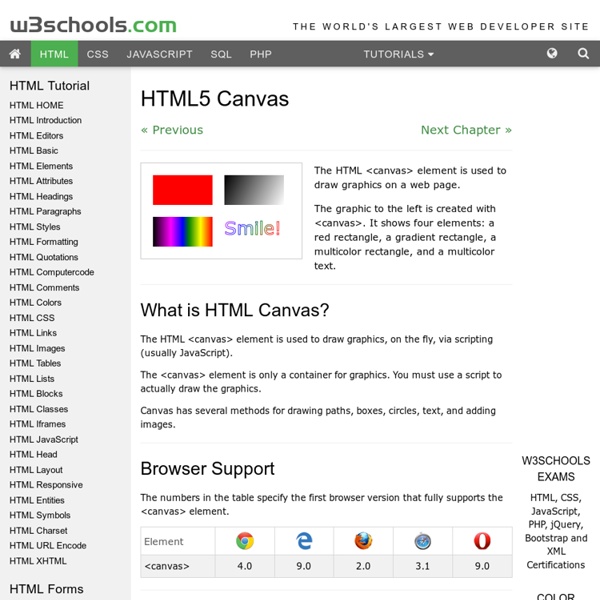



free-programming-books/free-programming-books.md at master · vhf/free-programming-books Literally Canvas Référence des fonctions - Manual Affecte le comportement de PHP » « Using SystemTap with PHP DTrace Static Probes Manuel PHP Edit Report a Bug Référence des fonctions ¶ Astuce Voir aussi Catégorie/Liste des extensions. add a note User Contributed Notes There are no user contributed notes for this page. Inducing Style Scope with HTML5 Canvas using the State Stack Published on October 25th 2012 by Eric Rowell What happens if we're creating large, complex canvas applications, and we have lots of methods and functions that draw things onto the canvas which can be executed in any order? We certainly don't want styles from different parts of our code base leaking into other parts of the code base. When working with HTML5 Canvas, we're constantly interacting with the canvas context object, which contains an abundance of cool styling properties and drawing methods. For a typical block of code that draws something onto the canvas, we draw a path, set a handful of context properties to style whatever it is we're drawing, and then use methods like fill() and stroke() to actually draw things onto the canvas. But what happens if we're creating large, complex canvas applications, and we have lots of methods and functions that draw things onto the canvas which can be executed in any order? Live Demo and Editor new window <! So what can we do do? <! Success!
Bootstrap 3 Tutorial An HTML5 Slideshow w/ Canvas & jQuery Martin Angelov You’ve probably heard a lot about the new HTML5 canvas element. As the name implies, this is a special element that allows us to create and modify graphics. In addition, we can also use it like any other element on the page – apply jQuery animations on it, listen for events and integrate it deeply into our layouts. All uses of canvas you’ve come so far are probably limited to games and other proof of concept demos. Update: Per popular demand, you can now download an auto-advancing version of this slideshow. The Idea With JavaScript, we are going to apply a special filter to every image in the slideshow. How the Slideshow Works When the user chooses to proceed to another slide, the canvas is shown with a fadeIn animation, creating a smooth lighting effect. The HTML The first step in creating the slideshow, is laying down the HTML markup of the page. html5-slideshow.html <! First we have the HTML5 doctype, followed by the head section of the document. The CSS styles.css Final words
Le pattern MVC en PHP Le modèle MVC (Modèle-Vue-Contrôleur) cherche à séparer nettement les couches présentation, traitement et accès aux données. Une application web respectant ce modèle sera architecturée de la façon suivante : Le traitement d'une demande d'un client se déroule selon les étapes suivantes : Le client fait une demande au contrôleur. Ce contrôleur voit passer toutes les demandes des clients. Une telle architecture est souvent appelée "architecture 3-tier" ou à 3 niveaux. L'interface utilisateur est souvent un navigateur web mais cela pourrait être également une application autonome qui via le réseau enverrait des requêtes HTTP au service web et mettrait en forme les résultats que celui-ci lui envoie. L'architecture MVC est bien adaptée à des applications web écrites avec des langages orientés objet. On mettra la logique métier de l'application dans des modules séparés des modules chargés de contrôler le dialogue demande-réponse. Dans le bloc [Logique Applicative], on pourra distinguer :
Aide mémoire pour Bootstrap | Maths, Info, etc. Twitter Bootstrap est une collection d'outils utile à la création de sites web et applications web. C'est un ensemble qui contient des codes HTML et CSS, des formulaires, boutons, outils de navigation et autres éléments interactifs, ainsi que des extensions JavaScript en option.Cette plate-forme a été conçue par deux développeurs faisant partie de la mouvance de développeurs qui gravitent autour de Twitter, Mark Otto et Jacob Thornton (@mdo et @fat).Ce site utilise un modèle basé sur Bootstrap. Cette page a pour objectif de lister les différents éléments gérés par Bootstrap pouvant être intégrés dans les pages et les articles utilisant ce modèle. La page est divisée en 12 colonnes.Pour écrire sur deux colonnes : <div class="row"><div class="col-lg-6"> Première colonne </div><div class="col-lg-6"> Deuxième colonne </div></div> Première colonne Deuxième colonne Pour écrire sur trois colonnes : Troisième colonne Boutons simples Boutons déroulants Taille des boutons Boutons de type bloc <! <h1 > h1.
Components Available glyphs Includes over 250 glyphs in font format from the Glyphicon Halflings set. Glyphicons Halflings are normally not available for free, but their creator has made them available for Bootstrap free of cost. As a thank you, we only ask that you include a link back to Glyphicons whenever possible. How to use For performance reasons, all icons require a base class and individual icon class. Don't mix with other components Icon classes cannot be directly combined with other components. Only for use on empty elements Icon classes should only be used on elements that contain no text content and have no child elements. Changing the icon font location Bootstrap assumes icon font files will be located in the .. Change the @icon-font-path and/or @icon-font-name variables in the source Less files. Use whatever option best suits your specific development setup. Accessible icons Modern versions of assistive technologies will announce CSS generated content, as well as specific Unicode characters.